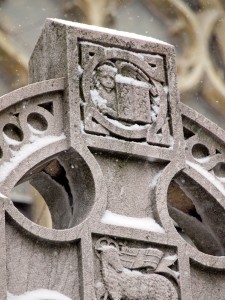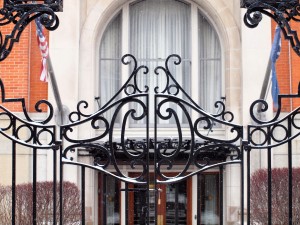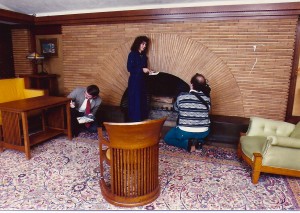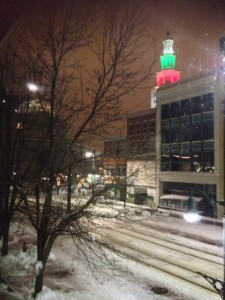Post Two of a Series on “Returning to A Renaissance In Buffalo”
As soon as it was humanly possible I left Buffalo and never intended to come back. After an architecture degree from University at Buffalo, I moved to New York City to get my Master’s in Historic Preservation at Columbia University. I became who I am today in New York City. I lived there for 19 years and I still consider it my beloved city. Buffalo is like my family – I had no choice in it, I was born and raised here and can never change that. NYC is like my best friend – I chose it. But Buffalo surprisingly gave me the sound base to have the courage to become me in New York City. It took me a really long time to acknowledge that it was okay to be from Buffalo and now 28 years after I first left I find it’s okay to come back.
When I left Buffalo in 1984, many of the iconic landmarks, which are being restored and reused today, had no future. I often say that sometimes the best preservation tool is patience. Patience and time. I can say that because I have witnessed the preservation wins that took decades and now have the wisdom that only time can give you. Of course, the buildings need to be still standing to allow them to be reused, and a recent spate of ill-conceived demolitions in Buffalo is certainly discouraging. Sadly though, it’s not just in Buffalo. In Gettysburg, it appears we’ve lost the battle to save Neutra’s internationally-known Cyclorama and in Chicago, the Landmarks Commission can’t stand up for what is right and has reversed its earlier decision to landmark Bertrand Goldberg’s Prentice Hospital. What this says to me is that preserving our heritage and story will always be under attack by those who believe that only new is good, or that what’s here now could always be better.

One of the fabulous architectural features that can be found on every corner, in every block of downtown Buffalo.
I moved back to Buffalo four months ago and find myself being an urban pioneer again – 20 years after I was an urban pioneer in SoHo. Still not sure that I want to be that again. It was one thing to get a loft on Broadway and Prince Street in 1993 when you’re 30 and bravely stupid, another to get a loft on the 500 block of Main Street when it’s two decades later. I’ll admit I sometimes get rather down when I look out my amazing huge commercial windows and see no activity. But then I remember everything that has changed since 1984 and it lifts my spirits. Below are some of the changes I have witnessed since I started architecture school in Buffalo in 1980, and one of the reasons I felt it was time to return. There are of course many more good stories, but these are a few that resonate with me on a personal and emotional level.
Sternberg-Trubee Mansion, now The Mansion on Delaware

The Mansion on Delaware, Buffalo’s premier boutique hotel, revived the long-vacant Sternberg-Trubee mansion.
The Sternberg-Trubee Mansion, a fanciful Second Empire mansion on Buffalo’s grandest residential avenue, was designed by architect George Allison in 1867. It was originally built for industrialist Charles Sternberg and occupied by several private owners over the years, the last being Samuel Curtis Trubee. Trubee turned it into a 100 room hotel and built an annex on the parking lot that now is the Buffalo Club parking lot. It operated as a hotel during the Pan American Exposition but during the Depression rumors were that it was really a bordello, allegedly frequented by Club members. My parents used to tell us stories of going to the Victor Hugo Wine Cellar Restaurant, which was located in the building from 1945-1977. Their stories reminded me of some swinging, hip parties, the kind you’d see on “Breakfast at Tiffany’s” or “Bell, Book and Candle.” Growing up though, it was abandoned and deteriorating and a blight on Delaware, next to the elite Buffalo Club.

The grand Buffalo Club, whose parking lot was once occupied by a hotel annex to the Sternberg-Trubee mansion, which some said was really a bordello.
When I was just out of school, working at Cannon Design in 1988, we were hired by a Canadian company to look at the moldering landmark and develop a scheme to make it their Canadian headquarters. It was a limited competition against another firm in town and we had two weeks to come up with an idea. I spent a solid week poking around the building, seeing it was in sound shape, with great potential. We didn’t get the project, but as it turned out, this project never went forward. It took another decade before a real plan was put forward, and in 2001 the Mansion on Delaware was opened, the first real and elegant boutique hotel in Buffalo.

When I worked at Cannon Design in the late 1980s, we “borrowed” the Darwin Martin House to make a film showing how to document historic buildings.
You can’t have been a young architect in Buffalo without your own stories about the world-famous Frank Lloyd Wright Martin House. Owned and used by the University at Buffalo when I was at school in the early 80s and still when I was running the Landmark Society of the Niagara Frontier from 1987-1990, the house was deteriorating in its own Wrightian way. One friend of ours lived in it as the caretaker. The pergola, “garage or stable” and conservatory were long gone, replaced by a 1950s apartment complex abutting the house. Martin’s sister’s house remained, as did the chauffeur’s house, both in separate ownership. I spent many evenings there, sitting on the Wright furniture with no curator to stop us. Architects and historians would have book clubs and lectures there. The Landmark Society had our annual dinner there one year. And just before I left Buffalo for my second long-term stint in NYC, our board members raised money to rescue an original window from the auction block. While I’m delighted, of course, that today the house has been restored and reconstructed to its original glory, those days and nights, spent with friends in the house drinking wine and waxing poetic about architectural philosophy, will always mean much more to me than taking one of its well-orchestrated tours ever could today.

Volunteers have worked for a decade to clean up the Central Terminal so it can be used for events and conferences.
As I’m writing this, it seems to me that much of my early years as an architect had to do with going to parties at our grand old ruinous landmarks. By the time I was in college, the Central Terminal had been closed for just a couple of years (closed in 1979), although it had never been fully occupied, having been opened during the depression on a site 2 ½ miles from downtown. I remember going to a Halloween party there my sophomore year, dressing up as a vampire and spraying my hair gold. It was wild and raucous, but as a budding architect whose mom had grown up a couple blocks away, I did have a special concern for this cavernous reminder of a long-gone transportation era. While the terminal is a long way from being a fully-occupied and used structure, there is a master plan in place with their leagues of volunteers and their first executive director, carefully and slowly restoring the place, one roof tile and one light fixture at a time.
The Buffalo Psychiatric Center now the Richardson Olmsted Complex

The fabulous towers of the Richardson Olmsted Complex have been beacons on Buffalo’s skyline since 1874.
Anyone who’s regularly read this blog knows that both my personal and professional careers have been wrapped around H. H. Richardson’s transformational asylum placed within Olmsted & Vaux’s park and parkway system.
I grew up in the suburbs but traveled to the west side every Sunday to have spaghetti at my grandmother’s house, driving down Elmwood and across Forest, wondering what those amazing towers were, and marveling over the wrought iron fence. It never scared me, just instilled wonder. And when I took my first architectural history course my freshman year of college at University at Buffalo, the first paper I wrote was on the “random” ashlar Medina sandstone of the building’s exterior. Mostly vacant since the 1970’s (in use for just about a century), I found my professional career continually winding back to this site. I wrote my master’s thesis on an adaptive use for the complex. Ran a program when I was at the Landmark Society to find a reuse for it which included a lecture series, international symposium and a book entitled “Changing Places: ReMaking Institutional Buildings.” Years later in 2006 I was appointed to the new Richardson Architecture Center board to work with the best board I’ve ever been on to restore, develop and manage the site. Now, with a real use of boutique hotel, architecture center and conference center in the midst of design, a child’s wonder is becoming a city’s revitalization engine.

My first architecture studio was beneath the tower on Hayes Hall, a space which is no longer considered habitable, but was a grand place to learn how to become an architect.
I could write more and more, like my memories of learning to be an architect in the tower of Hayes Hall, the oldest building on the University at Buffalo’s South Campus. Today, Hayes Hall is closed as it is rehabilitated into a LEED Silver state-of-the-art architecture school.
Or taking visitors to see the few bricks remaining from Wright’s long-gone Larkin Administration building. Today, I go to monthly Richardson meetings in the great long-vacant Larkin warehouses which have been adapted as the centerpiece of a new neighborhood called Larkinville.
The Lafayette Hotel, the American Industrial Building/Bethune Hall, the Statler Hotel. All have new lives. Even the grain elevators have found a way to engage artists and art lovers, bees and bee keepers.

The night time view out my window in downtown Buffalo. Goldome Bank to the Left, the Electric Tower to the right.
I may complain about the gray and the snow and the quiet downtown streets. But then I look out my window and I see the whimsical wedding cake of the Electric Tower and the gold dome of Goldome bank and I remember Christmas shopping downtown, eating big dinners at Chef’s and being treated to an annual visit to the Central Library, and life in Buffalo is good again.
And if you’d like to “subscribe” or follow my blog, True Green Cities, please sign up through the “Subscribe” button at the bottom left of this page. You’ll receive a daily recap when new blogs are posted. Or Sign up for the Feed.


